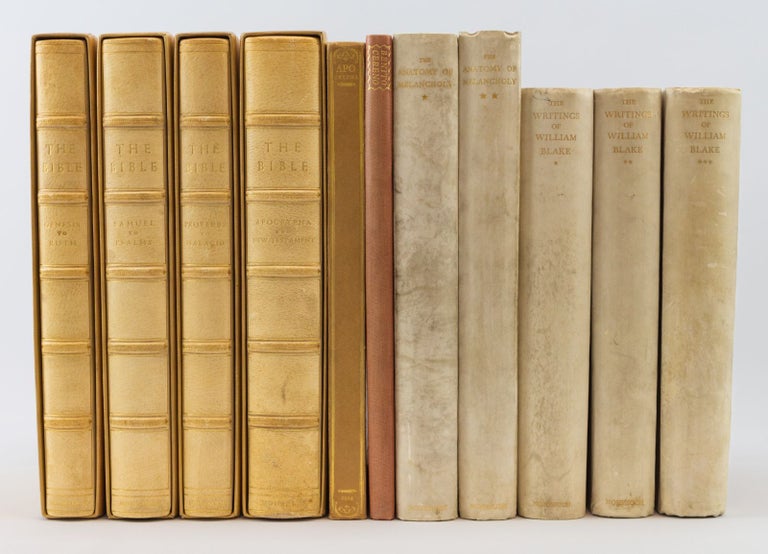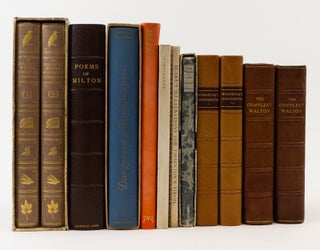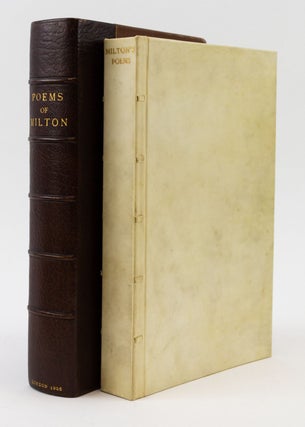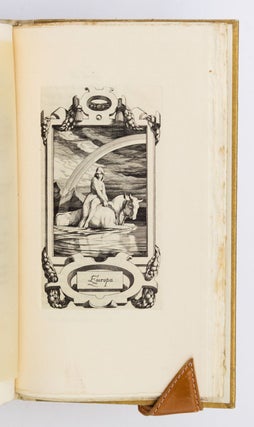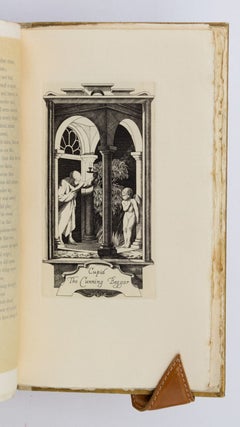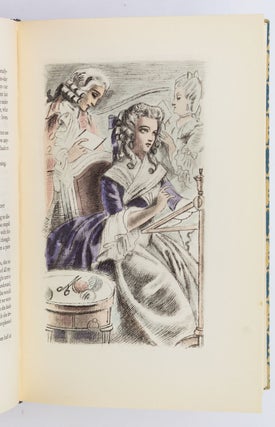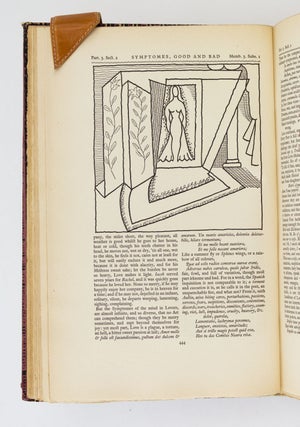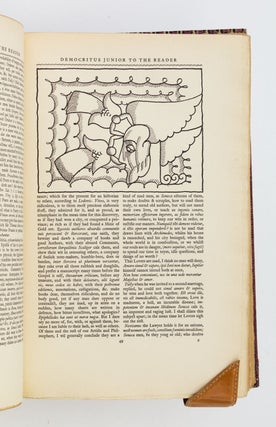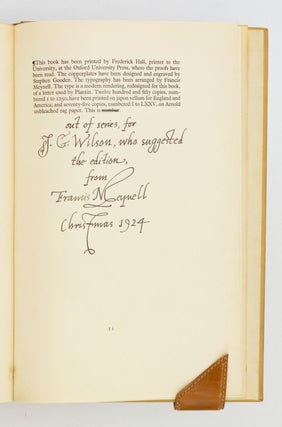FOURTEEN TITLES FROM THE NONESUCH PRESS, ALL IN ORIGINAL BINDINGS, OFFERED AS A COLLECTION.
This is a representative sampling of the Nonesuch Press, which produced a long string of substantial books with content of considerable importance and physical features showing significant aesthetic achievement. The press was founded in 1923 by typographer and book designer Francis Meynell (1891-1975) with the help of his friend David Garnett and his future wife, Vera Mendel. Meynell designed his books on a small Albion hand press, but had them printed commercially in order to keep the price of well-designed books made of quality materials within the means of readers and collectors who could not afford most private press editions. The Press produced a substantial corpus of fine printing, although the books were not produced exclusively to be collectible objects. As the "Prospectus of the Nonesuch Editions" says, "The Book Public may be divided into three parts. The Libraries cater for the section of it which reads books without wishing to possess them. A number of 'toy' presses cater for collectors who do not read. The Nonesuch Press was founded in the interest of those among the book collectors who also use books for reading." In furtherance of this goal, Meynell chose to print much-loved classic works, from Apuleius to Montaigne, Shakespeare to Dickens. Despite the fact that those who ran the Nonesuch Press (Meynell chief among them) did not take themselves too seriously, the press had a major influence on the history of the private press in England, especially between the wars. The titles included here are:
1) ANACREON. [ODES]. (Soho [London]: Nonesuch Press, 1923) 240 x 135 mm. (9 1/2 x 5 1/4"). Translated from the Greek by Abraham Cowley and "S. B." No. 175 OF 725 COPIES. Publisher's vellum-backed gold paper boards, flat spine with gilt lettering, edges untrimmed. WITH SEVEN COPPER ENGRAVINGS BY STEPHEN GOODEN. Text from the 1638 edition. Boards lightly chafed, trivial browning to untrimmed edges, but a fine copy, pristine internally.
This is the first book to be illustrated by Stephen Gooden (1892-1955), who would become known as one of the great book illustrators and engravers of his day. He worked on 14 Nonesuch titles and Meynell said of his work, "When you look at a Gooden engraving you are equally delighted with the design and with the execution." Horne says that he was a "literary" artist who was sensitive to the form of the book, aware of the possibilities of its page for decoration, and able "to appreciate the quality of the books he illustrated." He had "an imaginative grasp of the subject matter, and his witty and elegant illustrations are finely engraved and inventive in design."
2) BIBLE IN ENGLISH. THE APOCRYPHA. (London: [Printed at the Oxford University Press for] Nonesuch Press and Dial Press in New York, 1924) 310 x 190 mm. (12 1/4 x 7 1/2"). One of 1,250 Copies on Japon, THIS AN OUT-OF-SERIES PRESENTATION COPY INSCRIBED BY FRANCIS MEYNELL. Publisher's beige paper boards, covers stamped with gilt frame and centerpiece of Granjon type ornaments, flat spine with gilt lettering. In matching buckram slipcases lined with fleece. Fine title, headpiece, and tailpiece designed and engraved by Stephen Gooden. Dreyfus 20. Spine a little darkened and smudged, but easily soiled covers very clean, the binding with few signs of wear, and the contents pristine.
The colophon here has the final word "number" in the limitation statement struck through, and followed by this ink inscription in Meynell's italic hand: "out of series, for J. G. Wilson, who suggested the edition, from Francis Meynell, Christmas 1924."
3) BIBLE IN ENGLISH. THE HOLY BIBLE REPRINTED ACCORDING TO THE AUTHORISED VERSION 1611. (London: [Printed at the Oxford University Press for] Nonesuch Press and Dial Press in New York, 1925-27) 310 x 190 mm. (12 1/4 x 7 1/2"). Four volumes (the Apocrypha and New Testament bound in one volume). One of 1,075 Copies. Publisher's straw-colored buckram backed with white pigskin, raised bands, spine compartments outlined with gilt fillets, gilt lettering, marbled endpapers, all edges gilt. In matching buckram slipcases lined with fleece. Lovely titles, headpieces, and tailpieces designed and engraved by Stephen Gooden. Dreyfus 21; Herbert 2226; Rumball-Petre 125 ("a beautiful work of a famous press"). Spines evenly darkened to a pale beige, a couple of trivial smudges to exterior, but an especially fine set, immaculate internally, in unworn, atypically very clean bindings.
4) BLAKE, WILLIAM. THE ILLUSTRATIONS OF WILLIAM BLAKE FOR THORNTON'S VIRGIL. WITH THE FIRST ECLOGUE AND THE IMITATION BY AMBROSE PHILIPS. (London: Nonesuch Press, 1937) 240 x 150 mm. (9 1/2 x 5 3/4"). 38 pp. Introduction by Geoffrey Keynes. Publisher's cream cloth printed with an Italian pattern in gray, flat spine with gray vertical titling. With 17 wood engravings by Blake and three designed by him but cut by a journeyman engraver, eight engravings reproduced from Blake's original proofs, and 16 line drawings for the engravings reproduced in collotype. An additional suite of 17 engravings printed on individual leaves of Japon and housed in a gray paper folder inserted into pocket on rear pastedown. Dreyfus 110. A clean, fresh, and bright copy.
Printed from the recently discovered original blocks done for Thornton's 1821 Virgil. According to Dreyfus, "This was the first time that the engravings, the two surviving sheets of proofs, and sixteen of the original drawings were reproduced together."
5) BLAKE, WILLIAM. THE WRITINGS OF WILLIAM BLAKE. (London: Nonesuch Press, 1925) 280 x 190 mm. (11 x 7 1/2"). Three volumes. Edited by Geoffrey Keynes. One of 1,500 Copies on Vidalon handmade paper (and 75 on Oxford India paper). Original vellum-backed marbled paper boards, edges untrimmed. With 59 plates, including one double-page and the frontispiece, several illustrations in text. Dreyfus 24. Vellum with a little naturally occurring variation in the grain, spines slightly darkened and soiled, one with minor scratches, corners a bit worn, otherwise an excellent set, clean and fresh internally.
Under the supervision of Blake scholar Geoffrey Keynes, this set collected all known variant readings of Blake's prose and poetry. Maynell believed it "to rank with the Shakespeare as the most useful and most generally creditable of Nonesuch productions."
6) [BURTON, ROBERT]. "DEMOCRITUS JUNIOR," Pseudonym. THE ANATOMY OF MELANCHOLY. (London: Nonesuch Press, 1925) 314 x 197 mm. (12 3/8 x 7 3/4"). Two volumes. ONE OF 750 COPIES on paper (and 40 copies on Japon vellum). Original quarter vellum with Italian patterned paper covers, title in gilt on flat spine. With a total of 200 illustrations in the text by E. McKnight Kauffer, several of them repeated. Front pastedown with bookplate of Edwin C. Buxbaum. Dreyfus 24. Spines a little soiled, corners a bit rubbed, but an excellent set, clean and fresh internally and in well-preserved bindings.
This edition, printed with the subtle sensibility for which Nonesuch is well known, boldly introduced the work of "Democritus Junior" to the modern world. The great success of the project was in no small part the fault of Kauffer (1890-1954) and his sometimes startling illustrations. Though the book was an undisputed success, it stirred up considerable controversy with its images, as many did not agree with their very modern style. Sir Edmund Gosse felt that they were "hideous and irrelevant, and that a child would deserve to be smacked for drawing them." Roger Fry replied in the Burlington Magazine that he felt the book to be the most perfect example of illustration since Derain's "Enchanteur Pourrissant."
7) LACLOS, CHODERLOS DE. DANGEROUS ACQUAINTANCES (LES LIAISONS DANGEREUSES). (London: [Printed by the Imprimerie Protat Frères, Mâcon, France for] Nonesuch Press, 1940) 258 x 168 mm. (10 1/8 x 6 5/8"). xviii, 387, [1] pp. Englished by Ernest Dowson. Introduction by André Gide. Publisher's tan paper boards stamped with blue fleur-de-lys pattern, backed with blue buckram, flat spine with vertical gilt lettering. In the original cardboard slipcase (with split along one vertical joint, but no separation). With letterpress figurines representing the various correspondents by Bernard Wolpe, and 18 color illustrations by Chas. Laborde, 11 of these full-page. Dreyfuss 115d. A hint of sunning to spine, but a very fine copy, with no signs of use.
This classic epistolary novel featuring illicit relationships and betrayal is the first in a series of French romances produced by the press, with the collaboration of French printers, artists, and papermakers.
8) LAVER, JAMES. LADIES' MISTAKES. (Bloomsbury: Nonesuch Press, 1933) 222 x 145 mm. (8 3/4 x 5 3/4"). 3 p.l., 3-106 pp., [2] leaves. No. 120 OF 300 COPIES. Publisher's blue-gray marbled paper boards, silvered paper label to spine. In a (somewhat worn) matching marbled paper slipcase. Title page vignette and nine illustrations by Thomas Lowinsky. Dreyfus 88. Spine and extremities slightly rubbed, otherwise an especially fine copy, pristine internally, the fragile binding very well preserved.
This attractive printing on fine paper contains three works of moral verse by a popular contemporary writer: "A Stitch in Time," its sequel, "Love's Progress," and "Cupid's Changeling, or the Lady's Mistake." Though successful in the theatrical and literary worlds, James Laver (1899-1975) kept his day job in the Department of Engraving, Illustration, and Design at the Victoria & Albert Museum, where he worked for 37 years. He also wrote several notable works on art and fashion.
9) MARVELL, ANDREW. MISCELLANEOUS POEMS. (London: Nonesuch Press, 1923) 273 x 178 mm. (10 3/4 x 7"). 2 p.l., 148 pp, [3] leaves. No. 12 OF 20 SPECIAL COPIES (front a total edition of 850) printed with the name of subscriber Harold L. Jacob and bound in full vellum. Publisher's orange vellum, covers with gilt border and centerpiece based on a design by 16th century French binder Geoffroy Tory, smooth spine with gilt lettering, edges untrimmed. Facsimile of engraved frontispiece portrait from first (1681) edition. Dreyfus 4. Spine sunned to a pale tangerine color, boards somewhat splayed, otherwise a fine copy--clean, fresh, and bright inside and out.
The fourth book from the press, this collection reprints the text of the original 1681 printing, but with the restoration of pp. 116-31 and 140-44, which were removed from the first edition for political reasons and are reintroduced here from the unique copy in the British Museum that retained them. As Dreyfus notes, "the Nonesuch edition is therefore closer to the original plan of the first edition than was that book itself."
10) MELVILLE, HERMAN. BENITO CERENO. (London: Nonesuch Press, 1926) 315 x 200 mm. (12 3/8 x 7 3/4"). 4 p.l., 122, [2] pp. No. 1,189 of 1,650 Copies. Publisher's red buckram, smooth spine with gilt lettering. With 10 illustrations (seven full-page) by E. McKnight Kauffer, hand colored through stencils at the Curwen Press. Dreyfus 36. Spine faded to pale pink, but a fine copy, clean and fresh internally, with few signs of use.
This attractively printed and illustrated edition of Melville's 1855 maritime short story was proclaimed "one of the three best-looking books published in 1926" by the Double Crown Club.
11) MILTON, JOHN. WILLIAM BLAKE, Illustrator. POEMS IN ENGLISH. (London: Nonesuch Press) 253 x 157 mm. (10 x 6"). 3 p.l., 283, [1] pp.; 4 p.l., 359 pp. Two volumes bound in one. No. 72 OF 90 COPIES on Oxford Paper, bound in one volume (and 1,450 copies on Van Gelder paper, bound in two volumes). Publisher's stiff vellum, flat spine with gilt lettering, untrimmed edges. In brown cloth chemise and matching brown morocco-backed slipcase. 53 illustrations by William Blake printed in collotype by the Chiswick Press. Dreyfus 32. Boards tending to splay (as usual with vellum) but the chemise and slipcase acting as a deterrent, minor (naturally occurring) variations in the color of the vellum, gutters open after the first and before the final quire, with one-inch triangular tear at the former, otherwise an excellent copy, clean, fresh, and bright internally, in an unworn binding.
This was Meynell's own favorite of the Nonesuch productions; he found "the Blake illustrations . . . surprisingly right," and marvelled that "everything about the making of this book went easily from the beginning: a pretty sure sign of its success."
12) ROUSSEAU, JEAN JACQUES. THE CONFESSIONS. (London: Nonesuch Press, 1938) 230 x 140 mm. (9 x 5 1/2"). Two volumes. Introduction by Havelock Ellis. Translation revised and completed by A. S. B. Glover. No. 407 OF 800 COPIES. Publisher's natural Niger morocco, raised bands flanked by blind rules, dark brown morocco title label on each spine, top edges gilt on the rough, other edges untrimmed. With 12 woodcut headpieces by Reynolds Stone printed in reddish brown. Dreyfus 113. Spines evenly darkened to a pleasing tan, minor variations in the color and grain of the leather, but a very fine set with no signs of use.
This edition of the revealing and even sensational autobiographical "Confessions" of Jean-Jacques Rousseau (1712-78) represents a first and a last for the press: it was the first in which Meynell used Eric Gill's Perpetua roman font, and the last to be bound in leather by Bain of London. Dreyfus says that Meynell noticed the illustrator Reynolds Stone when his "engraved bookplates attracted a good deal of attention at a 'Sunday Times' exhibition in 1934." The present set was Stone's third effort for the press. Using the first English translation of 1783-90, the editor Glover corrected errors, modernized spellings, and translated sections that had been omitted from the 18th century edition for fear of offending public sensibilities.
13) WALTON, IZAAK. THE COMPLEAT ANGLER. [bound with] THE LIVES OF DONNE, WOTTON, HOOKER, HERBERT, & SANDERSON, WITH LOVE AND TRUTH & MISCELLANEOUS WRITINGS. ([London]: Nonesuch Press, 1929) 216 x 130 mm. (8 1/2 x 5"). x, 631, [1] pp. Edited by Geoffrey Keynes. First Collected Edition. No. 926 of 1,600 copies. Original russet morocco with central gilt medallion containing initials I. W., raised bands with gilt titling, top edge gilt on the rough, all other edges untrimmed, partly UNOPENED. With six black & white plates and 12 color in-text illustrations by Thomas Poulton and Charles Wright. Dreyfus 61. Boards a bit stained and soiled but unworn, and internally very fine.
Produced with the aim to unite the popular, disparate perceptions of Walton produced in readers who have only read one or another of Walton's well-known works, this collection was edited "with a discreet efficiency which allows Walton to speak for himself." (F. Meynell in a letter to G. Keynes) Included, of course, is his classic work on the art of angling, complete with wise fish lore, but also present are Walton's famous biographies of Donne, Herbert, Hooker, Henry Wotton, and Bishop Robert Sanderson. Though Walton knew all of these worthies except Hooker, and although he attempted to make his biographies factually accurate, he nevertheless "guilelessly transforms his subjects into his own image, that of a staunch, heart-of-oak traditionalist who views men and life with the eyes of an Anglican archbishop." (Day) His miscellaneous writings and Keynes' "Life of Walton" round out the collection.
14) WHITE, GILBERT. THE WRITINGS OF GILBERT WHITE OF SELBORNE. (London: Nonesuch Press, 1938) 265 x 160 mm. (10 3/4 x 6 1/2"). Two volumes. No. 244 OF 850 COPIES. Publisher's gray buckram, gilt ornament on front covers, flat spines in compartments containing a bird, insect, leaf, or turtle, gilt lettering, top edges gilded on the rough, other edges untrimmed. In original repaired marbled paper slipcase. Pictorial title pages, headpieces, and other ornaments from wood engravings by Eric Ravilious, folding maps of Selborne bound at end of volume II. Dreyfus 114. Spine sunned to a pleasing shade of lavender, but a fine set with no signs of wear.
These volumes contain White's much-loved "Natural History of Selborne," an account of the wonders of nature first published in 1789, as well as its sequels, "Antiquities of Selborne," and "Naturalist's Journal," along with some of White's letters. Like White, illustrator Eric Ravilious (1903-42) preferred life in the English countryside; DNB says his "work contributed to a new style of representing England and Englishness." (ST17616collections)
Price: $7,500.00

